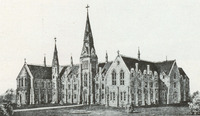1870s: Upstarts and Fire-Starters
With the Basilians assuming control of Assumption in 1870, their work was cut out for them. Assumption’s main building had been constructed in 1857 and was not up to date for its new educational system, and their enrollment numbers were extremely low [1]. Father Denis O’Connor was appointed as Superior of the College on July 20, 1870 to deal with these problems the Basilians were facing, despite having asked to be excused from the position due to his statement that he lacked the qualities, talent, or requirements to undertake such a position, calling it an “egregious folly” if he was to be appointed [2]. By the time of his appointment, the College only had 30 boarders and four day scholars, mainly from Detroit, a staff of six (including the future Superior of the College, Father Robert McBrady), and just $300 to its name from O’Connor, with no promise of government support [3]. Despite his concerns about his own capabilities, O’Connor successfully instituted an extensive building plan, with the goal of attracting more students from Michigan [4]. The first phase of this plan was completed in 1876, resulting in a brand-new east-west wing with three floors for classrooms, a chapel, and recreational areas, costing a pricy $20,000 at the time [5]. This wing was used by Assumption until it was torn down in 1984 [6].
Despite this brand-new building, Assumption College still dealt with the poverty that had haunted it since its inception. O’Connor’s letters to his Superior General explain “[t]here is no furniture in any of the master’s rooms, no mattresses, no bed clothes, no furniture for the classroom,” with students even having to provide their own beds [7]. In letters to his Superior in France, Father Soulerin, Father Robert McBrady, a future President of the College, outlines similar problems of poverty, with McBrady stating that he wrote the letter on a geography textbook for want of any tables [8]. McBrady had begun his studies in Paris in 1870, but with the outbreak of the Franco-Prussian War, was forced to return to Canada and was quickly posted to the newly re-opened Assumption College [9]. Despite Assumption’s problems of poverty and reputation, McBrady offers an optimistic view of Assumption’s future, stating that “[w]e have already 31 boarders and the College is only open since a week ago” [10]. McBrady’s optimism and O’Connor’s ambitious plans, bolstered by Assumption’s growing number of students, seemed ready to repair Assumption’s damaged reputation from the 1860s, but further problems were still to come.
On February 3, 1878, a moderate fire broke out, with students witnessing smoke billowing from the basement and the study room above it [11]. Despite the heavy smoke in the building, ensuing panic from students still in the building, and risky actions by a teacher, Mr. Falls, and two pupils, James Connell and Heiffel, to break a second-story window and jump into a snow bank, the fire resulted in only one reported injury, with Connell nearly losing a finger from broken glass [12]. Despite a prompt response from the Windsor fire department, the engine became stuck in the deep snow and the horses panicked, galloping away with the fire engine [13]. As a result, the college’s teachers and students, along with citizens from Sandwich and Windsor, put out the fire themselves, with the Detroit Free Press remarking that “[t]here is little doubt that but for the vigorous measures used, the splendid college building would have been utterly destroyed” [14]. The cause of the fire was attributed to a basement furnace that was left unattended, resulting in a fire that ignited a pile of cordwood and spread to the basement’s ceiling [15]. Damages, including a dilapidated study-room with charred joints and destroyed floor along with moderate smoke damage, were estimated to be $500, which today would total slightly over $13,000 in US dollars, but the College’s insurance was expected to cover some of the costs [16].
Despite the many challenges that O’Connor faced during the start of his tenure, Assumption College was preparing itself to become a major educational institution in the area, in size, enrollment, and influence, that would drive its accomplishments forward into the close of the century.
[1] Matthew R. Charbonneau, “Facing Detroit: Assumption College as a Cross-Border Institution 1870-1948” (master’s thesis, University of Windsor, 2020), 3. https://scholar.uwindsor.ca/major-papers/118.
[2] McMahon, 8-9.
[3] McMahon, 9; Kelly, 13.
[4] McMahon, 9.
[5] McMahon, 9.
[6] McMahon, 9.
[7] Shook, 72.
[8] Shook, 73; Michael Power, Assumption College: The Making of a Modern School 1890-1919 (Assumption University 1989), xiv.
[9] Power, xiii.
[10] Shook, 73.
[11] “A College on Fire: A Lively Time at Assumption College, Sandwich,” Detroit Free Press (1858-1922), 3 February 1878, 1.
[12] “A College on Fire,” Detroit Free Press (1858-1922), 3 February 1878, 1.
[13] “A College on Fire,” Detroit Free Press (1858-1922), 3 February 1878, 1.
[14] “A College on Fire,” Detroit Free Press (1858-1922), 3 February 1878, 1.
[15] “A College on Fire,” Detroit Free Press (1858-1922), 3 February 1878, 1.
[16] “A College on Fire,” Detroit Free Press (1858-1922), 3 February 1878, 1; Ian Webster, “CPI Inflation Calculator: 1878,” In 2013 Dollars.com, 2021. https://www.in2013dollars.com/us/inflation/1878?amount=500.



